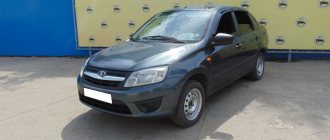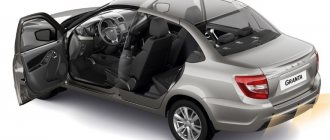Lada Vesta has been one of the sales leaders in the budget car segment for several years in a row. It confidently conquers new heights and it is with this model that AvtoVAZ sees itself in a bright future. However, 600,000 rubles is not the biggest money, but still quite large for residents of the outback. Therefore, many will still think about what to buy: a new domestic car or a used foreign car. In our case, as an alternative to Vesta, we will consider the second generation of Mazda 6, which was also one of the best in the D segment. Let's take a closer look at which of these cars to prefer.
A little about prices
With Lada Vesta everything is clear. To buy this car new, you will have to save up 607 thousand rubles - this is how much the model in the basic Standard configuration is valued at. The Russian sedan is powered by a 1.6-liter naturally-aspirated engine producing 106 horsepower. Transmission – five-speed “mechanics”.
Now, let's turn our attention to the used Mazda 6. Here we have a simply huge choice. In particular, you can afford a sedan, liftback or station wagon. Moreover, we emphasize that for 600,000 rubles you can look at restyled versions of the model - they are more recent in years and have gotten rid of many of the childhood diseases of the original version. The configurations can also be anything – up to the top-end. Therefore, you can easily count on the presence of dual-zone climate control, a sunroof, leather trim, xenon optics, a standard media system, rain and light sensors, parking sensors and much more.
As for the engines, they are as follows: 1.8, 2.0 and 2.5 liters with power from 120 to 170 horsepower. Transmissions - 5 manual transmission, 6 manual transmission or 5 automatic transmission. Drive is front-wheel drive only.
"Mass" premium
Let's start with the most common cars in the premium segment. This list will open with Lexus models, among which the RX300 stands out. For the price of Vesta, you can easily find an all-wheel drive crossover with a 200-horsepower gasoline engine, automatic transmission and left-hand drive. The car will be produced between 2000 and 2004, but its condition will not cause any particular complaints. In addition to prestige, a used RX is superior to VAZ’s new product in terms of equipment. If you look hard enough, you can find a Lexus with a panoramic roof, climate control, cruise control, and other goodies. There is no need to talk about the level of comfort in the cabin.
If a crossover is not exactly what you want, then the Vesta sedan can easily be replaced with the Lexus GS300 sedan from 1998 to 2003 or the Toyota Camry from 2004 to 2007. In both cases, you can find a car in almost perfect condition without visible external body defects or a “dead” interior. There is no need to explain that the GS300 and Camry are much higher quality, more prestigious and more comfortable than the new Vesta. In addition, even such an old Japanese premium offers much richer equipment. The only thing you have to put up with is the cost of maintenance, which Vesta has by an order of magnitude lower.
German cars can also be classified as mass premium. For example, the cost of Vesta is identical to the cost of Mercedes-Benz S-Class sedans produced before 2001, or the more common Mercedes-Benz E-Class 1999 - 2005. The old BMW 7-Series, as well as the first generation of the X5 crossover, are sold in the same price range. Both “Bavarians” will be produced between 2000 and 2004 and will allow the new owner to fully enjoy German quality instead of inhaling the “pleasant” aromas of the West plastic interior.
Body
Both Lada Vesta and Mazda 6 are very attractive cars. However, they profess different design styles.
Lada Vesta in its basic version looks exactly like this.
In particular, the Russian compact has X-shaped motifs everywhere - they mark the sides of the body and the front part. At the same time, the lines of the body itself are most often strict and devoid of any intricacies, and the harmonious proportions make Vesta desirable among both men and women, and of different age categories.
The second generation Mazda 6 is a more elegant sedan compared to its opponent. Attention is drawn to the muscular wings and wheel arches, lighting optics in the form of petals, a sloping roof that gives the car a swift profile, as well as a taut rear, regardless of the chosen body type.
Mazda 6 is more expressive and shocking compared to Lada, which, however, is not surprising.
In terms of geometric cross-country ability, these vehicles are approximately equal. In any case, the ground clearance of both models is 165 millimeters, so they will drive quite confidently on a country road, and there will be no problems parking near curbs.
The paintwork is thin in both cases and chips cannot be avoided. As for corrosion, on the Mazda 6 you need to look at the trunk lid, sills and wheel arches. Vesta's doors begin to rot over time.
Economical" VIP
Do you want absolute exclusivity? Well, Vesta’s price range allows for this too. For example, you can buy the brutal Chrysler 300C sedan, produced from 2004 to 2006. As a rule, such cars are not used every day, and therefore are kept in almost perfect condition. From time to time, the Jaguar X-Type sedan 2002 - 2006 with a gasoline engine and front-wheel drive appears on sale.
With difficulty, but you can find a very valuable rarity - a Ford Mustang, which came off the assembly line in 1996 - 2000. Well, if this doesn’t seem enough to you, then for the price of Vesta you can buy an absolute exclusive - a Lincoln Town Car limousine, released no later than 2003.
Around the cabin
In terms of interior, the Mazda 6 confidently takes the lead. Here, the center console looks very intriguing, which is slightly turned towards the driver and glows in different colors. At the same time, the instrument cluster is recessed into the wells and has a red backlight, which puts you in a perky mood. At the same time, on-board readings are transmitted to a narrow window on the dashboard - there are big problems with its readability on a sunny day.
Vesta’s salon is empty and dull.
The Lada Vesta also has an instrument cluster in the wells. But its execution is extremely low-cost - the inexpressive and uninteresting diagram of the radial instruments is depressing, although they are not bad to read. The central one in the basic versions is an empty platform with a connector for a radio - there is nothing more to say about it.
The low-set front seats of the Japanese sedan are extremely comfortable and perfectly support the body in corners. There are only two points - tall drivers are unlikely to like the shortish cushion, and heavy ones will complain about the strong squeezing of the seat filler. In Vesta, the seats do not have any distinct lateral support, although they are quite comfortable in profile - they will do for everyday driving, and there is enough range of adjustments, but no more.
Yes, the steering wheel is worn out, but everything else, including the glossy inserts on the dashboard, is in excellent condition.
If we talk about the sofas of the second row, then here we can note a strong parity between these two models. In particular, with a height of up to 185 centimeters, there is enough legroom in both places. But in a Russian car there is even a little more headroom.
It is unlikely that anything will break in your new Lada. However, sometimes owners complain about the stabilization system not working correctly and the instrument lighting quickly burning out. Also, the braid of the steering wheel and the fabric on the seats wear out quickly - up to mileage of 50 thousand kilometers.
In the Mazda 6, the leather on the seats begins to crack only after 200,000 km, and the steering wheel looks good up to 150 thousand. The upholstery fabric lasts about the same amount of time.
No particular problems were found with the on-board equipment. Perhaps the standard audio system may stop reading CDs, and the heating threads may break. A frayed wiring harness in the driver's door risks causing the central locking to fail.
Technical condition
But then experts reassure those motorists who want to purchase a used version of the popular Russian model: “Everything is fine with the technical part of this car - the condition of the units of this car is even better than that of models that are considered “indestructible.” A third of the Vestas we examined had serious clutch wear and abnormal operation of the heater; about a quarter showed increased vibration when shifting the gearbox.” Short-lived shock absorbers and a muffler sagging on rubber bands are another distinctive feature of the three-year-old Lada Vesta.
Here, Vesta has surpassed in quality not only the Renault Logan of two generations, but also left behind the Nissan Almera and even the Volkswagen Polo:
Motors and gearboxes
In terms of acceleration dynamics, the Mazda 6 takes a confident lead over the Russian Lada Vesta. Moreover, an interesting fact is that even the 1.8 liter engine drives extremely well. But for 600 thousand rubles you can easily take a closer look at 2.0 and 2.5 liter engines. The latter will completely leave the domestic model far behind, even with an automatic transmission. And in general, Mazda has a more responsive throttle drive and precise operation of the manual transmission, and fast automatic transmission. Therefore, Vesta has no chance in this discipline.
Vesta is very spacious in all directions.
By resource. The VAZ 1.6 liter engine is quite simple and reliable - it won’t cause big problems up to 100,000 kilometers. As for the manual transmission, elements of the switching mechanism, clutch and synchronizers can wear out.
Mazda 6 engines are also very reliable and run up to 300,000 kilometers without problems. However, with high mileage, you need to carefully monitor the timing chain, thermostat, oil pump and oil-water heat exchanger.
The low roof of the Mazda makes the seating position worse for tall passengers.
There are questions about manual transmissions. In particular, the clutch and rocker are not very durable. But all this applies, for the most part, to the 2.5 liter version. The weak points of the automatic transmission are poor sealing of the heat exchanger and clutches.
What if it’s not a sedan, but a crossover?
Or maybe give up buying a sedan and opt for a crossover? If you look at cars no older than 2016, the choice is very small. And these will be front-wheel drive cars made in China. You will have to choose from only two brands of models: Lifan and Chery.
Lifan X60 is the most popular crossover from China on the Russian market. The first generation of the car is distinguished by an abundance of chrome (which peels off over time) and quite rich equipment.
Lifan X60 is the most popular crossover from China on the Russian market. The first generation of the car is distinguished by an abundance of chrome (which peels off over time) and quite rich equipment.
The first generation X60 crossover, popular with Lifan, has a 1.8-liter engine producing 128 hp. and a CVT can be found even cheaper: for 600–620 thousand rubles for a 2016 car. True, the mileage will be close to 80 thousand kilometers. The equipment is not the poorest: the interior is upholstered in leatherette, there is an audio system with USB, two airbags and ABS. The machine is quite common, so there should not be any problems with its maintenance and repair. But you should approach the purchase with extreme caution: we came across two mortgaged cars, two with VIN codes that did not match the advert and one that had been in an accident (the seller, naturally, writes about “factory paint all around”).
The photo shows an expensive version with a two-tone interior trim, but even cheaper versions will have eco-leather upholstery.
The photo shows an expensive version with a two-tone interior trim, but even cheaper versions will have eco-leather upholstery.
For approximately the same amount you can find (if you try really hard) a Chery Tiggo 5 with a 2-liter engine (139 hp) and a CVT. The car will be three years old with a decent mileage (from 20 thousand kilometers per year) and not in very good condition. The package also includes two airbags, ABS, an audio system, and leather seats. The weaknesses of this model have long been studied, so there should be no problems with spare parts or repairs.
We will have to look for a used Chery Tiggo 5 with our budget; they usually try to sell cars that are three years old for a higher price. |
The Tiggo's interior has some pretensions to originality, but the finishing materials here are inexpensive, and the steering wheel trim peels off quite quickly. |
Of course, you can look at older cars, then the equipment will be richer, and the choice will be wider among both sedans and crossovers. But if you are choosing between Vesta and a used foreign car, Behind the Wheel recommends not buying a car older than three years. Otherwise, you will have to spend much more on possible repairs. In addition, do not forget that our Lada Vesta is new, which means it is under warranty and most of the possible problems will be fixed for free.
- We will help you choose a good roof rack or special mounts for transporting equipment for any car.
Photo: AVTOVAZ, Ford, Nissan, Peugeot, Lifan, auto.ru
New Vesta or a used foreign car? Choosing an alternative
Chassis
Lada Vesta lacks quick reactions on the steering wheel, and in general, the steering is not very informative, moreover, it is a bit empty. But we must pay tribute to the Russian sedan - it is quite stable in corners and does not frighten with high rolls, although it exhibits strong understeer.
Compared to its rival, the second generation Mazda 6 is a more solid and nimble car. The heavy and sensitive steering wheel, the highest straight line stability and the almost neutral nature of steering with minimal roll are extremely pleasant. However, what is puzzling here is the significant step in effort when turning the steering wheel sharply - this is not very convenient when parking and can be disorienting during emergency maneuvering.
When it comes to driving comfort, the Lada Vesta has no equal. It has a very long-travel and energy-intensive suspension, which practically does not notice small irregularities and withstands impacts from large potholes with honor. The Japanese sedan handles any unevenness with shaking for its riders, and when fully loaded, its suspension can even pierce.
As for the resource, on a Mazda up to 50,000 km wheel bearings, steering tips and rods, and stabilizer rods may require replacement. Silent blocks and shock absorbers last at least 100-120 thousand kilometers.
On a Lada Vesta, shock absorbers are unlikely to reach 100,000 kilometers. However, the same may apply to the silent blocks of the front and rear suspensions and ball joints. Therefore, you will have to visit the service center on a Russian sedan to overhaul the suspension more often.
What is better - a used foreign car or Lada Vesta?
Lada Vesta is already three years old! On the one hand, we can say: how quickly time flies! But if you look at the question from a different angle, you can state an unconditional fact: since November 2015 (the start date of Vesta sales), the new domestic model not only has not lost its relevance, but is even increasing its popularity. All this as a whole speaks of a successful combination of design and technical components of the model. Is it so?
If few motorists have questions about the appearance of AvtoVAZ’s new product, then from the technical side, not everything is so simple with the car. It took not only time to collect information and feedback about the new product from its owners, but also the work of professional analysts from large companies who monitor the car market. And now the time has come. The CarPrice analytical department calculated scores for the operation of a domestic sedan, compared it with foreign cars from the budget segment and made intermediate conclusions.
What conclusion can we draw?
Of course, you might think that a new car is a new car and there will be fewer problems with it. However, think about how long you can drive the Lada Vesta without any problems, given the not-so-high quality of the model’s components.
Think about the fact that for 600,000 rubles you can find extremely good Mazda 6s with 2.0 or 2.5 liter engines - both with manual transmission and with everyone’s favorite automatic transmission. At the same time, the Japanese sedan will be equipped in every way better than the basic domestic compact. With all this, it is unlikely that it will be possible to avoid investments. But if you set out to bring the Japanese model to fruition, you won’t have any problems with it for a long time.
Conclusion: we buy a used Mazda 6. But we pay attention to possible corrosion of the body and the clutch in the manual transmission. Also, it would be a good idea to check the timing chain in the engine. Lada Vesta is suitable only for those who do not want to waste time choosing a used car.
Is it cheaper?
For 635–650 thousand rubles you can find a Nissan Almera assembled in Izhevsk, and you can come across cars with very low mileage and additional equipment (for example, a non-standard audio system with a large screen and a rear view camera, an alarm and tinted rear windows). The sedan has a 102-horsepower gasoline engine under the hood, coupled with a time-tested 4-speed automatic transmission.
Externally, the Nissan Almera is very similar to the Bluebird Sylphy for the Japanese market. But don’t believe your eyes: the body is “stretched” on the Renault B0 platform, and technically the car is completely identical to the first generation Logan. By the way, in Russia they have already stopped collecting Almera.
Externally, the Nissan Almera is very similar to the Bluebird Sylphy for the Japanese market. But don’t believe your eyes: the body is “stretched” on the Renault B0 platform, and technically the car is completely identical to the first generation Logan. By the way, in Russia they have already stopped collecting Almera.
Once you get into the Almera salon, don’t be surprised that you could already see it on another model. Yes, this is the “seamless” interior of the first generation Renault Logan. With all its cheap materials, annoying ergonomics and not the highest seat comfort.
Almera's strong point is its spacious rear sofa. That is why the car was often used as a taxi. Before purchasing, checking for a permit to operate as a taxi is required!
Almera's strong point is its spacious rear sofa. That is why the car was often used as a taxi. Before purchasing, checking for a permit to operate as a taxi is required!
But such a car causes a minimum of problems. But service at Nissan branded service stations will cost more than Vesta from official dealers.
The condition of the Lada Vesta interior is the best in the segment
But in the interior of the Vesta 2015, everything is just fine. No competitors among foreign cars were identified among the cars that passed the pre-sale research!
“The signature disease of the model can probably be attributed to the rapid wear of the steering wheel. And altered seat upholstery and various stains are a feature of the operation of specific cars,” CarPrice sums up the state of the interior after three years of operation.











